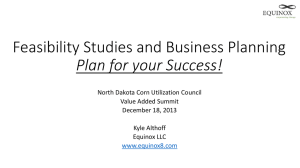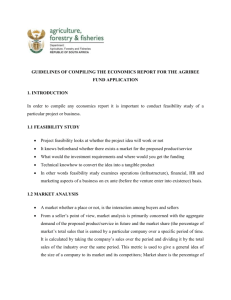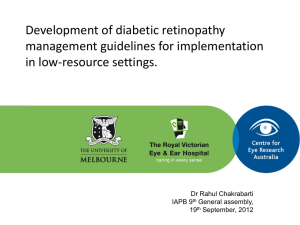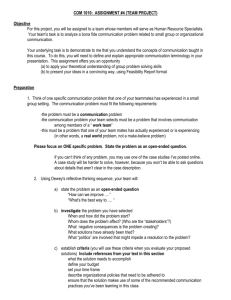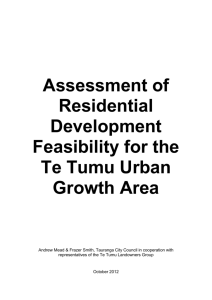Assessment of Residential Development Feasibility
advertisement
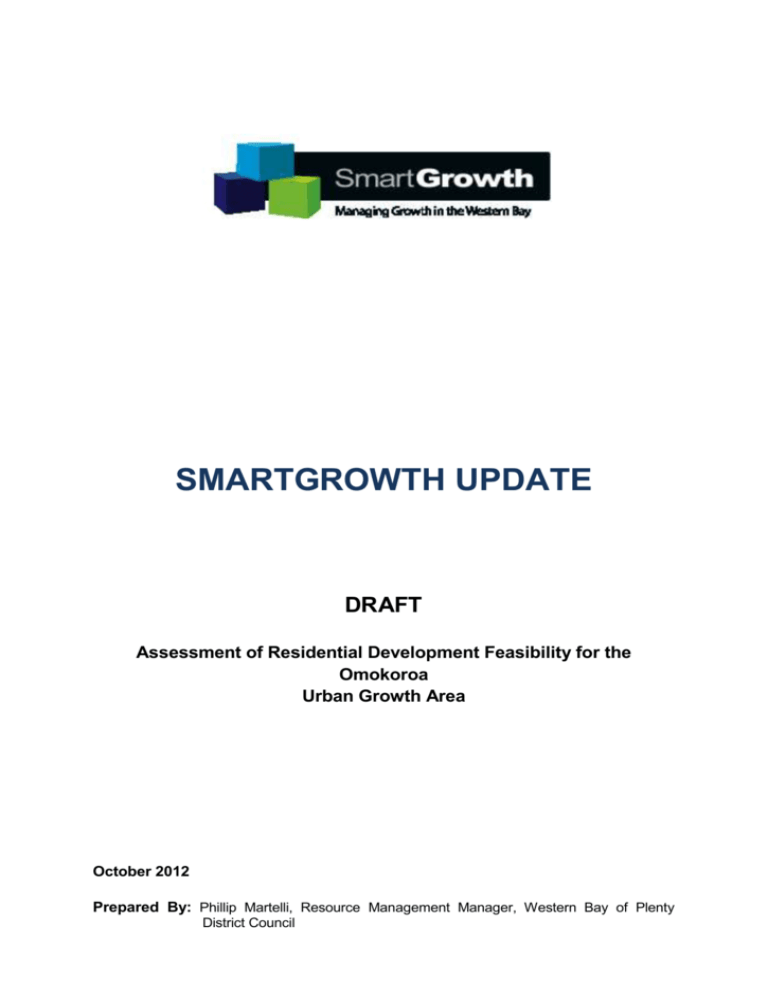
SMARTGROWTH UPDATE DRAFT Assessment of Residential Development Feasibility for the Omokoroa Urban Growth Area October 2012 Prepared By: Phillip Martelli, Resource Management Manager, Western Bay of Plenty District Council Table of Contents 1. Executive Summary...................................................................................................... 3 2. Report structure............................................................................................................ 4 3. Purpose ......................................................................................................................... 4 4. Background ................................................................................................................... 4 4.1 4.2 4.3 4.4 4.5 4.6 5. Development Feasibility Methodology / Data Inputs................................................. 6 5.1 5.3 5.4 5.5 5.6 5.7 5.8 6. Base model results ............................................................................................ 9 Other Issues ................................................................................................................ 10 7.1 8. Land development model .................................................................................. 6 Revenue inputs ................................................................................................... 6 Cost inputs .......................................................................................................... 6 Inflation................................................................................................................ 8 Financial analysis ............................................................................................... 8 Timing of revenues and costs ........................................................................... 9 Goods and services tax ..................................................................................... 9 Residential development feasibility results ............................................................... 9 6.1 7. Location............................................................................................................... 4 History ................................................................................................................. 4 Current land uses and land owners ................................................................. 5 Growth projections............................................................................................. 5 Infrastructure servicing costs ........................................................................... 5 The importance of considering the financial viability of development ......... 5 Council debt ...................................................................................................... 10 Conclusions ................................................................................................................ 10 2 1. Executive Summary The primary purpose of this research is to assess the financial viability of development in the Omokoroa urban growth area which has been earmarked in the current SmartGrowth Strategy as growing from a settlement of 2,000 population to a town of 12,000. To assess the feasibility of development in Omokoroa the hypothetical development model that was built for the 2010 Wairakei development feasibility project by Tauranga City Council was used. This is a Microsoft Excel spreadsheet based model that includes all of the costs and revenues associated with land development and the timing thereof. The model allows the financial performance of a development proposal to be calculated from the perspective of the developer. The model itself is very similar to that used for most major property developments. Development in Omokoroa has been significantly affected by the global financial situation. The model shows development in Omokoroa to not be viable if the standard profit for developers is used. At best development is considered to be marginal and, notwithstanding, development is occurring at Omokoroa and the challenge in particular is for Council to manage the level of financial contributions. Omokoroa should remain as part of the Smartgrowth Settlement Pattern, but it needs to be recognised that it will take longer for the town to fully develop than previously projected. 2. Report structure This Report is structured as follows: 3. Purpose Background Development feasibility methodology and data inputs Residential development feasibility results Other issues Conclusions Recommendations Appendices. Purpose The purpose of this project is to: a) Assess the financial viability of residential development in the Omokoroa urban growth areas given: b) c) 4. Omokoroa’s role in providing for the sub region’s future population growth through developing from a village of 2,000 people to a new town accommodating 12,000. . Identify any other issues or challenges to development in Omokoroa aside from financial viability. Identify measures that could improve financial viability and/or address other issues that are identified. Background This section of the Report provides background information on the Omokoroa urban growth area. 4.1 Location 4.1.1 Omokoroa is located to the north of Tauranga City and is a peninsula in the Tauranga Harbour. The proposed growth management area covers from State Highway 2 to the end of the peninsula (see map in Appendix). 4.2 History 4.2.1 Omokoroa has been identified for future urban development for many years. The role of Omokoroa as a future urban growth area was formalised through the construction of a wastewater pipeline from Omokoroa to Tauranga that was commissioned in 2007. The pipeline was chosen from a number of options to address wastewater contamination issues in the Tauranga Harbour caused by on-site septic tank systems. To develop an affordable system required a greater population than existed at the time, and hence the planned expansion of Omokoroa. Stage 1 was zoned in 2002, and the Stage 2 Structure Plan was approved in 2008 with part of the Structure Plan becoming operative in 2010. 4 4.3 Current land uses and land owners 4.3.1 Stage 1 comprises mostly small lots of around 1 ha because of an old Tauranga County Zone, many of which have substantial dwellings. Stage 2 is a mix of lifestyle, orchard, and grazing blocks, and therefore a range of lot sizes. 4.4 Growth projections The size of Omokoroa is physically constrained by the State Highway and Tauranga Harbour. The timing of the planning for Stage 2 meant that it was the first growth management area (along with Te Puke) under the umbrella of SmartGrowth. There was a requirement, therefore, that the residential component of Stage 2 had to achieve an overall average of 15 dwellings per hectare. This requirement, plus the estimates for Stage 1 and infill in the existing village, resulted in a total proposed population of 12,000 for the whole peninsula. This has been anticipated to occur over a 30 year period. 4.5 Infrastructure servicing costs 4.5.1 A significant amount of infrastructure needs to be built to provide for urban development in Omokoroa, much of which is likely to be initially debt funded by Council and recovered through the levying of financial contributions. The most significant is wastewater which has had to be completed prior to any development occurring. The other infrastructure is able to be progressively upgraded as development occurs. 4.5.2 Furthermore, infrastructure investment will be undertaken by the New Zealand Transport Agency (NZTA), as part of the ongoing upgrades to SH2 including the Tauranga Northern Link and Te Puna to Omokoroa four laning. 4.6 The importance of considering the financial viability of development 4.6.1 The term financial viability refers to whether development would be sufficiently profitable for the developer/landowner to be willing to undertake and for project finance to be secured. It would be easy to consider that local authorities should not be concerned about this and that they should leave it to the developers to worry about. There are a number of reasons that counter this argument, for example: To ensure that the SmartGrowth settlement pattern is realistic and could be delivered it is important that growth is not allocated to areas that would never be developed because they are not financially viable. Local authorities often have to invest tens of millions of dollars to service new growth areas in the form of lead infrastructure which is required prior to development commencing. Given this, local authorities can face significant financial challenges if infrastructure investment occurs in areas that prove to be financially unviable to development. In a general sense it is much more difficult to put together a financially viable development now than it was say 10 or 20 years ago in the Western Bay of Plenty. There can be significant difference between the financially viability of development in different parts of the sub region due to varying development costs and market prices for sections in different locations. 5 5. Development Feasibility Methodology / Data Inputs 5.1 Land development model 5.1.1 To assess the feasibility of development in Omokoroa the hypothetical development model that was built for the 2010 Wairakei development feasibility project was used. This is a Microsoft Excel spreadsheet based model that includes all of the costs and revenues associated with land development and the timing thereof. The model allows the financial performance of a development proposal to be calculated. 5.1.2 The model was built using the in-house financial modelling expertise within Tauranga City Council based on specifications provided by independent property development expert Martin Udale. The model itself is similar to that used for most major property developments. It has previously been reviewed and approved by Martin Udale himself, the three development companies in Wairakei that were involved in the Wairakei work, and Epsilon & Associates Ltd. 5.2 Data Inputs 5.2.1 Data inputs were sourced independently as follows: Estimated section prices from Colliers International Development contributions and other Council costs from Council staff All other land development costs Aurecon Consultants who were contracted to provide such information because of their extensive experience in the Omokoroa area. 5.3 Revenue inputs 5.3.1 Revenue comes from the sale of developed land. Sale prices for developed land (i.e. residential sections) were obtained from a registered valuer (Nigel Dean of Colliers International). A range of sale prices were provided based on different section sizes ranging from 200m2 to 800m2 with average sale prices of $110,000 to $180,000 respectively. 5.3.2 It is likely that some sections will achieve higher prices where there are harbour or Kaimai views, which is possible in many localities on the peninsula. 5.4 Cost inputs 5.4.1 Cost inputs into the land development equation can be broken down into the following categories: Land purchase costs Development setup costs Construction costs Council costs Indirect costs Direct sales costs Project finance costs. 6 Land purchase costs 5.4.2 Underlining land values for Omokoroa (as kiwifruit orchard) range from $100,000 to $150,000 per hectare. The rates are substantially lower if the property is in pasture. Development setup costs 5.4.3 Development setup costs are associated with planning approval processes associated with the rezoning of land. Most of these costs have already been incurred for Omokoroa, although there will be additional costs when the remainder of Stage 2 is zoned for urban purposes. Construction costs 5.4.4 Construction costs can be divided into estate costs (bulk infrastructure) and per lot costs. Estate costs relate to the cost of building infrastructure assets that cannot be staged as development proceeds e.g. lead infrastructure. There is relatively little in the way of estate costs for Omokoroa as most lead infrastructure is built by Council and funded by way of financial contributions. Estate cost estimates have been sourced from Aurecon Consultants and from Council’s own experience with similar projects. 5.4.5 Per lot construction costs relate to the direct costs of delivering finished lots. They are made up of earthworks, roads, services (water, wastewater, stormwater, electricity, gas and telecommunications), landscaping, design and supervision. Per lot construction costs have been sourced from Aurecon Consultants based on their experience with projects in Omokoroa. Council costs 5.4.6 Council costs relate to resource consents (both land use and subdivision), 223 and 224 certificates, financial contributions and rates. The costs are based on Council’s operative fees at the time the report was written. Indirect costs 5.4.7 Indirect costs include utilities, insurance, site office, security, office expenses, project management, administration, legal, consultants, bank charges, valuations, accounting and marketing. The costs for these items in the Wairakei development feasibility modelling have been adopted. Direct sales costs 5.4.8 Direct sales costs are made up of real estate agent commissions and legal costs associated with sale and purchase agreements and the transfer of legal title. The Wairakei feasibility modelling costs have again been adopted. Project finance 5.4.9 Project finance relates primarily to the interest incurred on debt used to finance the project. Holding costs have been calculated on the net debt position of the project over time. The interest rate used to calculate holding costs is 8%. This figure has been agreed as a reasonable long term average by the TCC Project Team in consultation with TCC’s Treasury Manager and property lending experts within the banking sector. 7 5.4.10 The financing assumptions used in the financial model are relatively simple. They are that: Land purchase cost will be funded 50% by debt and 50% by equity Other costs will be funded 70% by debt and 30% by equity A minimum working capital amount funded by equity of $1m at all times A bank interest rate of 10% which is assumed to also include all bank fees e.g. the cost of settling up and rolling over banking facilities. 5.4.11 Other financial measures commonly used in relation to property development financing such as loan to value ratios (LVRs) and interest cover ratios have been ignored for the purposes of this project due to the complexity that they add. 5.5 Inflation 5.5.1 All costs used in the financial modelling are assumed to be in 2012 dollars. 5.5.2 The financial modelling assumes no inflation for a number of reasons: Difficulty of making accurate assumptions about what inflation is likely to be, especially in regards to section prices (revenue) That if both costs and revenues are inflated by the same amount they largely cancel each other out To mitigate risk, the financial viability of a development should not rely on significant increases to section prices over the project’s lifespan i.e. the development should ‘stand on its own feet’ given current information about costs and revenues. 5.6 Financial analysis 5.6.1 Three financial measures are used to analyse whether development is feasible. They are the gross margin, the project internal rate of return and the equity internal rate of return. These are commonly used in the evaluation of development projects by developers and financiers. 5.6.2 The gross margin is a key measure of the financial viability of the project. It is calculated by dividing net profit before tax by total costs. A gross margin of about 20% or greater would be acceptable for the project to proceed. 5.6.3 Internal rate of return (IRR) is another measure of a project’s profitability. In more specific terms, the IRR of a project is the interest rate at which the net present value of costs (negative cash flows) of a project is equal to the net present value of the benefits (positive cash flows) of a project. Two IRR calculations are used to assess development feasibility. 1. The Project IRR (excluding funding costs): This measures the return on investment for all cashflows (revenues and expenses) in the project excluding funding costs. A Project IRR in the range of about 18-20% is broadly acceptable for development to proceed. 2. The Equity IRR: This measures the return on equity by calculating the interest rate required to make the net present value of equity injections and withdrawals equal to zero. An equity IRR in the range of 20-25% has been agreed as broadly acceptable for the purpose of development proceeding. 5.6.4 While developers own expectations of an appropriate gross margin and internal rate of return are important, the main driver of the agreed gross margin and internal rates of return is what the banking industry would expect to see if it 8 were to provide project finance. It is critical that these measures are acceptable to the banking sector as without project finance, development cannot be undertaken. In light of this the assumptions adopted above were reviewed and approved as being reasonably reflective of banking industry practice by ANZ National Bank through the earlier Wairakei development feasibility work. 6. 5.7 Timing of revenues and costs 5.7.1 The timing of revenue and costs is driven by the agreed development scenario. It is assumed that section sales will increase overtime as developments build momentum. This is broadly consistent with the earlier work that was done for Wairakei. 5.7.2 Given the timing of the delivery of finished lots, costs and revenues have been timed to occur in a realistic fashion. The majority of costs are incurred prior to sales revenue being received. 5.7.3 The timing of costs and revenues is important as it determines the overall debt position of the development and thus the amount of interest costs incurred. To minimise interest costs it is assumed, within reason, that costs will be incurred on a just in time basis. 5.8 Goods and services tax 5.8.1 All costs and revenues in the financial model are gst exclusive. However when considering retail section prices, gst is added because consumers are required to pay gst. Residential development feasibility results 6.1 Base model results 6.1.1 The cost and revenue assumptions used in the base model are set out in Table 1 below. Table 1: Omokoroa Cost and Revenue Assumptions Revenue Ave. Section Sale Price Cost Land Purchase Lot Construction Costs Financial Contributions Rates Other Council Fees Direct Sales Costs Development and Project Management Other Costs Bank Interest Total Costs 15 lots per ha $ per lot % of total (excl. GST) costs 12 lots per ha $ per lot % of total (excl. GST) costs $ 132,609 $ 145,217 $ 9,333 $ 52,638 $ 43,248 $ 1,862 $ 3,916 $ 5,065 7.6% 42.9% 35.3% 1.5% 3.2% 4.1% $ 11,667 $ 59,510 $ 43,258 $ 1,853 $ 4,028 $ 5,380 8.8% 44.9% 32.6% 1.4% 3.0% 4.1% $ 3,978 $ 720 $ 1,885 $ 122,645 3.2% 0.6% 1.6% $ 4,357 $ 800 $ 1,739 $ 132,592 3.3% 0.6% 1.3% 9 6.1.2 Table 1 above identifies that the most significant costs of development are construction costs of the sections and financial contributions. These costs combined make up 70% of the total development costs. It may be possible to reduce construction costs, but such savings are likely to be only minor. 6.1.3 The most significant impact is likely to be in reducing financial contributions. There are two possibilities. The first is to reduce the levels of service of infrastructure provided, such as the width of roads. This can have a dual benefit of reducing costs, and also freeing up land to be used for creating additional sections. The second is to reduce the actual contributions paid by reviewing the assumptions of the financial contribution model. In particular this will involve the allocation between existing ratepayers and new development. 6.1.4 The financial viability is summarised in Table 2 below. Table 2: Base Model Financial Summary 15 lots per ha 12 lots per ha Min Required 6.1.5 7. 8. Av. Section Price (inc GST) at which Feasible Av. Section Price (excl. GST) Av. Section Price (incl. GST) Gross Margin Project IRR Equity IRR Feasible? $132,609 $152,500 8.12% 6.50% 7.70% No $176,563 $145,217 $167,000 9.52% 7.70% 8.80% No $191,412 20%+ 18-20% 20-25% Table 2 shows that at the estimated average section price a profit can be made, but it is substantially less than what the developers and financiers normally require. Other Issues 7.1 Council debt 7.1.1 Funding of local infrastructure generally involves Council incurring debt to fund this infrastructure which is then repaid as financial contributions are collected as development proceeds. 7.1.2 Forecast Council debt for Omokoroa specific infrastructure e.g. wastewater, stormwater and roading is expected to average $46m over the planning period to 2036 and peak at $61m in 2028. Reserves and water supply related debt are minor. Conclusions 8.1.1 The financial modelling as a whole indicates that there are challenges to development being financially viable in Omokoroa. In terms of the model, notwithstanding that a profit can be made, development in Omokoroa is not feasible as it does not give the developer the standard rate of return. Developers operating in Omokoroa have indicated that development is still feasible for them (though not as profitable as elsewhere) as long as a tight rein is kept on the level of financial contributions. 10 8.1.2 Because of the significant investment made in infrastructure, it is logical to retain Omokoroa in the current SmartGrowth Settlement Pattern. The challenge will be for Council to manage the level of financial contributions. 8.1.3 An option for Council is to use rates to ease the burden of financial contributions as has been done by Tauranga City Council with West Bethlehem. 8.1.3 Omokoroa is seen as having a favourable lifestyle type of living environment with pleasant views and easy access to the Harbour, including for boating. This assists with Omokoroa being able to command higher section prices. However there are factors that are perceived by some to be seen as detractors. These are limited opportunity for retail (especially grocery), and potentially a secondary school. Another issue is State Highway 2. At the time that Omokoroa Stages 1 and 2 were approved, State Highway 2 was planned to have the Tauranga Northern Link and Te Puna to Omokoroa four laning completed by now. Due to Central Government changes in funding priorities these roading improvements have not occurred, and will still be some years away. If these various matters were to be resolved then Omokoroa is likely to see a lift in growth rates which, in turn, will help keep the rein on financial contributions. 11 Appendix - Omokoroa Structure Plan Stage Boundaries
